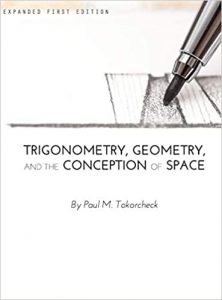Point of Contact
Elijah Stines
515-294-6405
Catalog description
MATH 1450. Applied Trigonometry (2-1) Cr. 3 F.S. Prereq: Satisfactory performance on the placement exam, 2 years of high school algebra,1 year of high school geometry, or enrollment in MATH 1400. Mathematical ideas regarding the conception of space. General Trigonometry, with an emphasis on the calculation of lengths, areas, and angles. The Law of Sines and the Law of Cosines. Polar, cylindrical, and spherical coordinate systems. Conic sections and Quadric Surfaces. Students in the College of Liberal Arts and Sciences may not count Math 1450 toward the General education requirements. Only one of Math 1430 and 1450 may count toward graduation.
Textbook
Trigonometry, Geometry, and the Conception of Space (Expanded First Edition)
Paul Tokorcheck
ISBN: 9781634871877
Syllabus
Module One: Definitions (3 weeks)
Lessons 1-5
Module Two: Applications (4 weeks)
Lessons 6-11
Module Three: Coordinate Systems (3 weeks)
Lessons 12-16
Module Four: Conics (3 weeks)
Lessons 17-20
Module Five: Quadrics (3 weeks)
Lessons 21-24
Objectives
MODULE ONE: DEFINITIONS, LESSONS 1 − 5 (3 Weeks)
- Understand general definitions regarding sets, particularly sets of numbers.
- Distinguish between integers, rational numbers, and irrational numbers.
- Use units of measure and convert between units, using dimensional analysis.
- Understand both radian and degree measures and how to translate between them.
- Know the six trigonometric ratios. Be able to evaluate trigonometric ratios using both a calculator and the Unit Circle.
- Given data about a right triangle, be able to find any missing side lengths or angles.
MODULE TWO: APPLICATIONS, LESSONS 6 − 11 (4 Weeks)
- Understand concepts relating to functions, such as their domains, ranges, and whether or not they are one-to-one.
- Know the six inverse-trigonometric functions. Be able to evaluate trigonometric ratios using both a calculator and the Unit Circle.
- Be able to solve equations relating an unknown angle, either for a unique solution or over interval.
- Use basic trigonometric identities, such as the Sum/Difference Formulas, the Law of Sines, and the Law of Cosines, to help solve equations.
- Construct and solve equations for a variety of real-world examples.
- Be able to find unknown side lengths or angles for general triangles.
MODULE THREE: COORDINATE SYSTEMS, LESSONS 12 − 16 (3 Weeks)
- Use Polar Coordinates to describe points or equations in two dimensions, and convert between them and rectangular coordinates.
- Use Cylindrical Coordinates to describe points or equations in three dimensions, and convert between them and rectangular coordinates.
- Use Spherical Coordinates to describe points or equations in three dimensions, and convert between them and rectangular coordinates.
- Be able to graph sinusoidal curves, and identify features such as amplitude and period.
- Manipulate the sine function and its graph using transformations of the plane.
MODULE FOUR: CONICS, LESSONS 17 − 20 (3 Weeks)
- Recognize the graphs and equations of parabolas, ellipses, and hyperbolas.
- Complete the square to put quadratic equations into standard forms.
- Analyze the equations of conics to identify features such as foci and vertices. Modify a given conic section using graph transformations.
MODULE FIVE: QUADRICS, LESSONS 21 − 24 (3 Weeks)
- Use level curves to describe general surfaces in R3.
- Be able to both identify and generate surfaces of rotation and their features.
- Recognize the graphs and equations of cones, ellipsoids, paraboloids, and hyperboloids in R3.
- Be able to sketch a given quadric surface and its intersection with specified horizontal and vertical planes.

